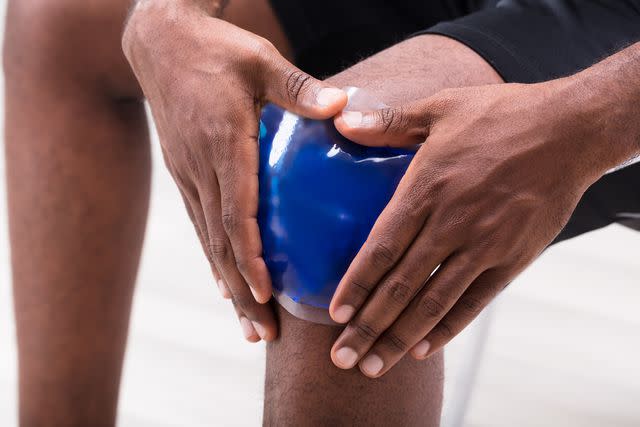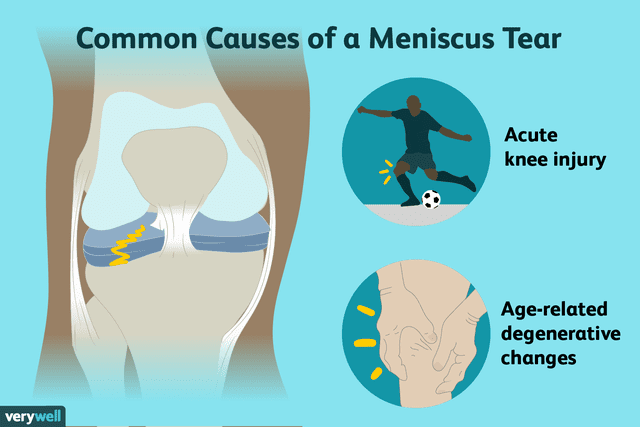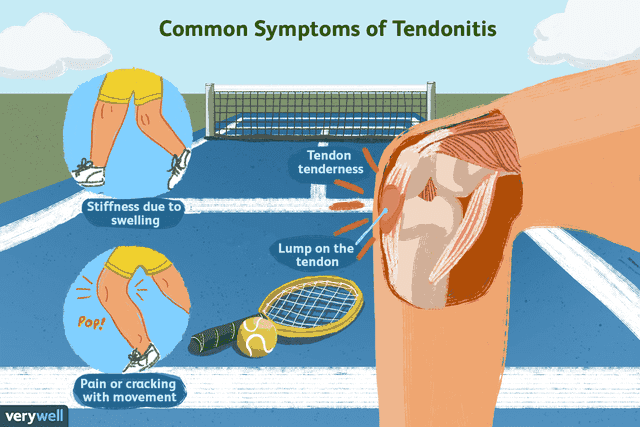When to Use Heat or Ice for Knee Pain
Medically reviewed by Oluseun Olufade, MDFact checked by Nick Blackmer
Depending on the situation, both ice and heat can be effective and convenient options for easing knee pain. However, because each treatment works in different ways, it is essential to consider your specific condition before selecting one or the other.
By better understanding the benefits and risks of each treatment, you can appropriately choose the right option for you. This article explains knee pain causes and when ice or heat is most appropriate.

AndreyPopov/Getty Images
Causes of Knee Pain
While numerous problems and conditions can lead to pain in your knee joint, some are more common than others. The most common causes are arthritis, cartilage tears, sprains or strains, and tendonitis.
Arthritis
Arthritis can result from “wear and tear” in the joint or an autoimmune condition. Osteoarthritis is the most common type of knee arthritis. It is degenerative, meaning it occurs over time as the cartilage (the tissue that coats the end of the bones in the joint and helps you absorb force) begins to thin and wear away.
This condition typically occurs in middle and older-aged individuals. However, it can happen to younger people, especially those with excess weight or after a traumatic knee injury.
People with arthritis generally experience knee pain, stiffness (primarily in the morning and after a long day), and swelling in the joint itself.
Tears
The cartilage in your knee, namely your meniscus, can tear following a traumatic injury. These tears usually happen after a “plant and twist” movement. It most commonly occurs while playing sports or performing more physical tasks at home or work.
In addition to joint soreness, a cartilage tear can also cause the following symptoms:
Knee locking
Limited range of motion
Swelling
Knee that “gives out”

Alexandra Gordon/Verywell
Sprains or Strains
Knee sprains or strains occur when a structure in the joint is overstretched or torn following a traumatic injury. A sprain impacts a ligament (tissue that connects adjacent bones), while a strain affects a tendon (tissue that attaches muscle to bone).
While many different sports and activities can cause a sprain or strain, sudden twists or direct blows to the knee are relatively common culprits. Depending on the severity of the injury, these issues can cause symptoms like:
Knee pain
Leg instability
Bruising
Swelling
Related: The Difference Between a Sprain and a Strain
Tedonitis
Tendonitis occurs when tendons become irritated and inflamed. It is usually the result of muscular overuse during activities like running, jumping, or biking.
The knee pain associated with tendonitis typically comes on gradually. Initially, it may only hurt while doing the aggravating sport or exercise. However, as the tendonitis progresses, the soreness becomes more frequent and constant.

Verywell/Jessica Olah
Recap
Many things can cause knee pain, including arthritis, meniscus tears, sprains or strains, and tendonitis.
Using Ice
Ice is an easy and accessible treatment option if your knee is hurting. Ice treats pain by causing blood vessels to narrow (called vasoconstriction), leading to decreased blood flow to the area. Because of this, icing can relieve inflammation, decrease swelling or bruising, and reduce soreness or pain.
Injuries
Icing is beneficial following an acute knee injury (less than six weeks old). The following injuries may benefit from ice:
Meniscal tear
Sprain
Strain
Tendonitis
Icing injuries can reduce inflammation and help prevent pain and swelling. Along with activity modification, icing may also keep some injuries, like tendonitis, from progressing.
How to Apply Ice
When applying ice to your joint, use an ice pack, a bag of crushed ice, or even a frozen bag of vegetables. Apply the cold object directly over the affected area. Be sure to use a towel as a barrier to make the temperature tolerable.
Each icing session should last a maximum of 20 minutes. Use caution when icing if you have any sensation issues, such as diabetic neuropathy or Raynaud’s syndrome, which can impact your ability to feel the cold and lead to frostbite or skin damage.
Recap
Ice is best for acute injuries like sprains, strains, tears, and tendonitis. It works to reduce inflammation and relieve pain. You can use crushed ice or a bag of frozen vegetables placed on the affected knee for up to 20 minutes at a time.
Related: R.I.C.E. Treatment for Acute Musculoskeletal Injury
Using Heat
Applying heat to a sore knee can also be helpful in specific circumstances. Unlike ice, heat increases the blood flow to your joint by widening (vasodilating) the blood vessels in the area.
This type of treatment is usually not helpful after an acute injury. That's because the goal with an injury is reducing the inflammation. However, it can be beneficial when dealing with a chronic issue.
Arthritis and Chronic Pain
For people with arthritis or other joint issues that have been present for longer than six weeks, heat can help reduce pain and soreness. It can also improve your knee’s flexibility and range of motion by relaxing the surrounding muscles before you stretch or begin an activity.
How to Apply Heat
When administering heat to your knee, use a heating pad that is warm but not hot. Apply it over the affected area and keep it on for a maximum of 20 minutes or until it becomes uncomfortable.
Again, people with sensory issues should use caution with heat to avoid any burning or skin damage.
Recap
Heat works oppositely as ice in that it widens blood vessels, which increases blood flow to the area. This therapy is most useful for chronic conditions like arthritis. You should use a heating pad that is warm but not hot and apply it to the affected area for up to 20 minutes.
Using Both Heat and Ice
In some situations, applying both ice and heat to your joint may be helpful. This treatment is called contrast therapy. It involves alternating between icing and heating a joint.
This option has traditionally been used after exercise or participating in a sporting event to recover. However, it may also be helpful for more chronic conditions, like arthritis.
To use heat and ice, alternate applying hot and cold packs at different times of the day. Alternately, you can submerge the knee in hot or cold water.
While those who received contrast therapy reported less overall soreness and muscular fatigue, the research is still mixed. The current evidence is lacking on whether this treatment helps manage the pain associated with a knee injury or reduces your inflammation levels.
Recap
Research is mixed on the benefits of using both heat and ice. However, some people find it beneficial, especially for treating chronic conditions like arthritis.
Related: Water on the Knee (Effusion) Causes and Treatments
Summary
Many things can cause knee pain, including arthritis, meniscus tears, sprains or strains, and tendonitis. Ice and heat therapy can often help with pain, inflammation, and mobility. However, certain conditions respond better to different treatments. For example, ice works best for injuries, whereas heat is a better therapy for more chronic conditions. Sometimes it is helpful for alternate heat and ice, especially for arthritis.
A Word From Verywell
If your knee pain is not improving, or if you experience progressive swelling, knee instability, or your leg starts to give way, it is vital to be seen by a physician. Getting medical attention is especially urgent if your knee pain occurs from a traumatic injury or a direct blow to the joint. Consulting with a doctor can speed your healing and allow you to return to normal activities sooner.
Frequently Asked Questions
How does ice reduce swelling?
Applying ice to an injury can reduce swelling by restricting its blood flow. This might sound like a bad thing, but oftentimes, the body can cause too much swelling to occur after an injury. It does this in an attempt to repair and protect the damaged tissues. Using ice reduces the flow of fluids to the injured area and allows for some swelling, but not enough to cause further harm.
How long do you alternate heat and ice?
If you decide to alternate using heat and ice for knee or back pain, you can start by applying heat for 15 to 20 minutes. After a few hours have passed, apply ice to the knee or back for 10 to 15 minutes. Some people may find that alternating heat and ice can help arthritis the most, as opposed to pain caused by an injury or chronic condition.

